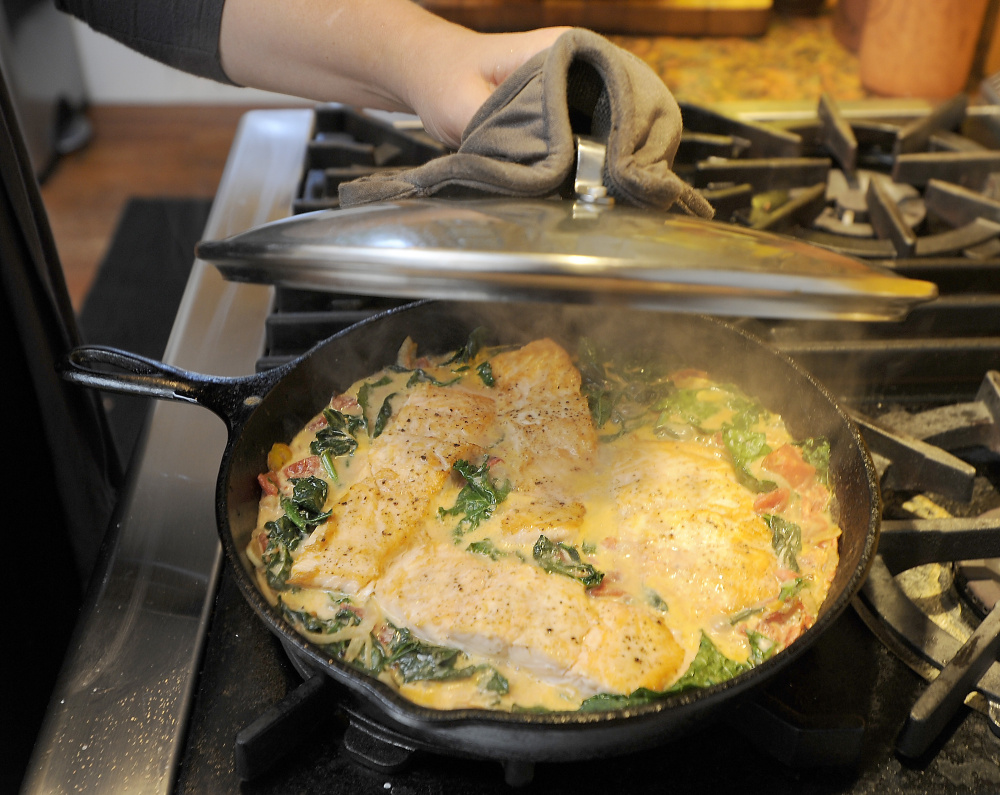Last month I taught my 17-year-old son, Owen, how to cook skinless broiled salmon. I routinely dress up an underused species of fish (redfish, hake, pollock or whiting) with a squeeze of lemon and butter-coated bread crumbs, so the family can judge which they like better than haddock and cod. Owen willingly eats them all, but he always comes back to salmon.
In the fish case at Hannaford, my choices are typically sockeye salmon ($8.99/pound, previously frozen, wild caught in Alaska); fresh, all natural Atlantic salmon ($12.99/pound, farm-raised off the coast of Scotland using organic feed and no antibiotics); and “regular old farmed salmon” as the clerk explained ($8.99/pound, fresh, raised in Maine but processed in Canada). Which is the greener choice?
Yes, it swam with lots of other fish in its natural habitat, eating its rightful prey, and it offers the strongest salmon flavor. But the sockeye traveled a long way to sit, thawed, on ice at Hannaford.
Organically fed and antibiotic free is a great tagline, but the coasts of Scotland and Maine are 3,000 miles apart.
Long-standing arguments about “regular old farmed salmon” claim the environmental costs are too high to render it truly sustainable, but recently those arguments are being called into question as outdated perceptions.
Compared to how long farmers have raised domesticated animals for food, salmon farming in Maine is in its infancy, said Sebastian Belle, executive director of the Maine Aquaculture Association. Salmon hatcheries were established in the 1880s to help rebuild the wild Atlantic salmon population, but it wasn’t until 40 years ago that salmon farming in the Atlantic began in earnest in Maine. “We learned as we went along and there were failures that affected both the fish and the environment,” Belle admitted.
But he argues much has changed in the Maine salmon aquaculture industry.
Fish farmers have customized what and when they feed their salmon. Farmed salmon today eat meal formulated with only about 28 percent forage fish like herring and mackerel (down from 95 percent), the rest coming from sustainably farmed plant proteins. This reformulation lessens the burden that salmon farming places on those wild fisheries.
To help keep food waste in the ocean low, fish farmers use underwater cameras to keep an eye on how quickly the farmed salmon eat. Moreover, the ratio of pounds of meal required to produce one pound of salmon has been reduced from 5 to 1, to almost 1 to 1 in best-case scenarios, Belle said.
Modern Maine salmon farmers practice something akin to crop rotation. According to Steve Eddy, a biologist with the Center for Cooperative Aquaculture Research at the University of Maine, all permitted farm sites are selected to ensure adequate flushing (when the waves and currents disperse waste from fish pens) when the pens are full of salmon. One-third of Maine’s 25 permitted salmon farming sites sit fallow each year. This dormancy allows the sites to flush completely.
Antibiotic use has also dropped off dramatically, since these days all young salmon are vaccinated against the bacteria they’ll like encounter when placed into the ocean. Belle explains that through the work of Maine firms like Kennebec River Biosciences Inc. in Richmond, these vaccines have been tailored to address location-specific bacteria and have kept the use of antibiotics in Maine salmon farms to a bare minimum.
Belle’s best advice to salmon consumers is to ask to see the box the salmon came in. If it says the fish come from Maine or Canada, eaters can be assured the fish has been raised to the highest standards of sustainability.
If it comes from elsewhere in the world, make sure it carries the Best Aquaculture Practices Certification seal of approval.
ONE-PAN SALMON WITH SPICY CREAMED GREENS AND TOMATOES
This recipe works well with all types of salmon, wild-caught or farmed. Serve the fish with crusty bread.
Serves 4
4 (5-ounce) skinless salmon fillets
Salt and pepper
2 tablespoons olive oil
1/2 cup chopped sweet onion, such as Vidalia
2 garlic cloves, thinly sliced
1/2 teaspoon red pepper flakes
8 cups chopped greens (such as spinach, kale, mustard greens or Swiss chard)
1 cup chopped tomatoes
1/4 cup vegetable, seafood or chicken stock
1/2 cup cream
Season the tops of fillets with salt and pepper. Heat 1 tablespoon oil in large, heavy skillet over high heat until very hot. Place the salmon, seasoned-side down, into the hot pan to sear for 3 to 4 minutes. Remove the fish from the pan to a plate. The fillets will not yet be cooked through.
Lower the heat to medium. Add the remaining 1 tablespoon oil. Add the onions and sauté until they start to soften, about 4 minutes. Add the garlic and red pepper flakes. Cook for 1 minute.
Add the greens and ½ teaspoon salt. Use a pair of tongs to turn the greens in the oil. Add the tomatoes, stock and cream. Stir to combine.
Nestle the salmon fillets, seared side up, into the greens. Cover and cook for 5 minutes for medium rare salmon, 10 minutes if you prefer your salmon more well done.
Christine Burns Rudalevige is a food writer, recipe developer and tester, and cooking teacher in Brunswick. She can be contacted at cburns1227@gmail.com.
Send questions/comments to the editors.



Comments are no longer available on this story